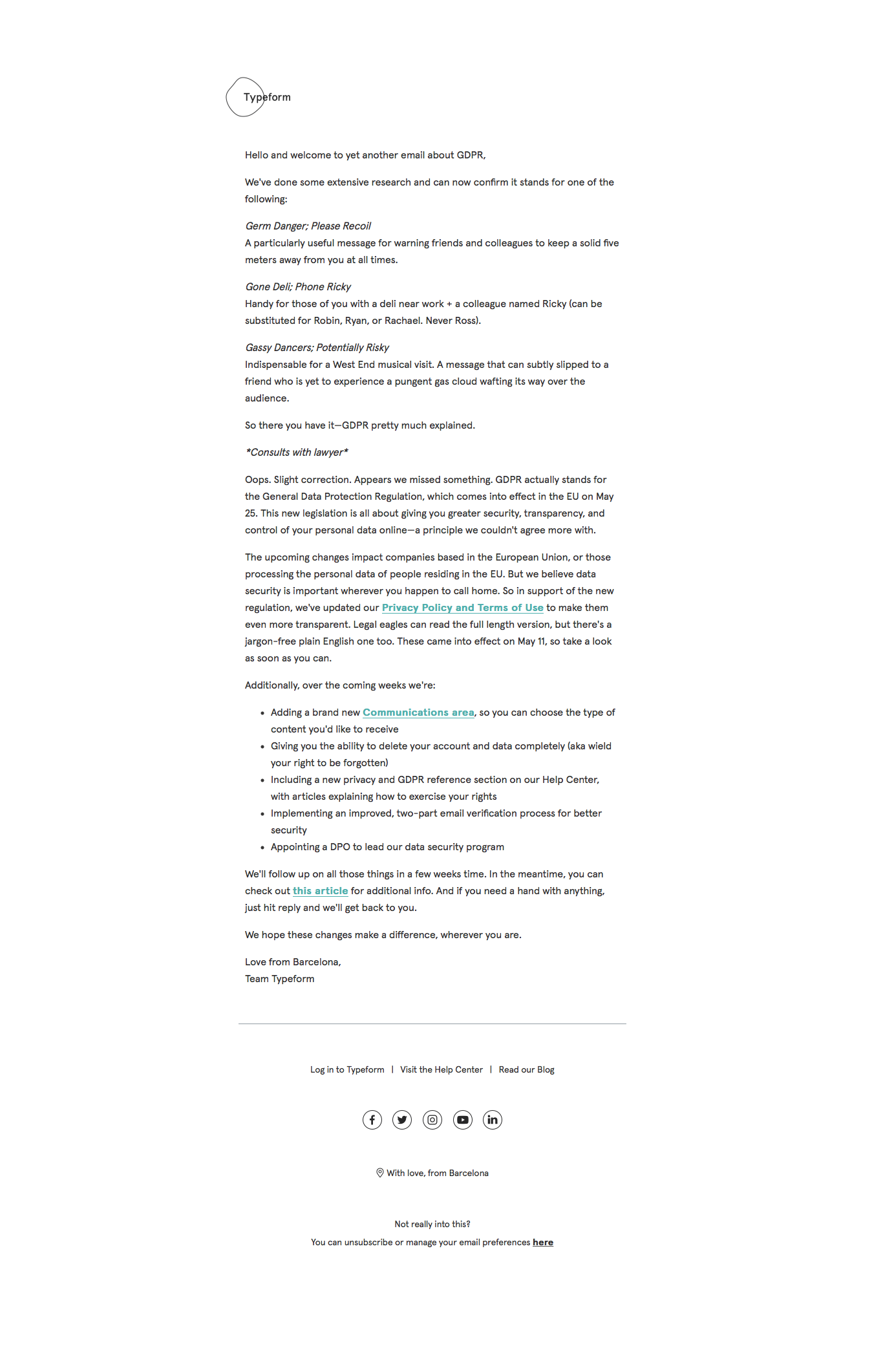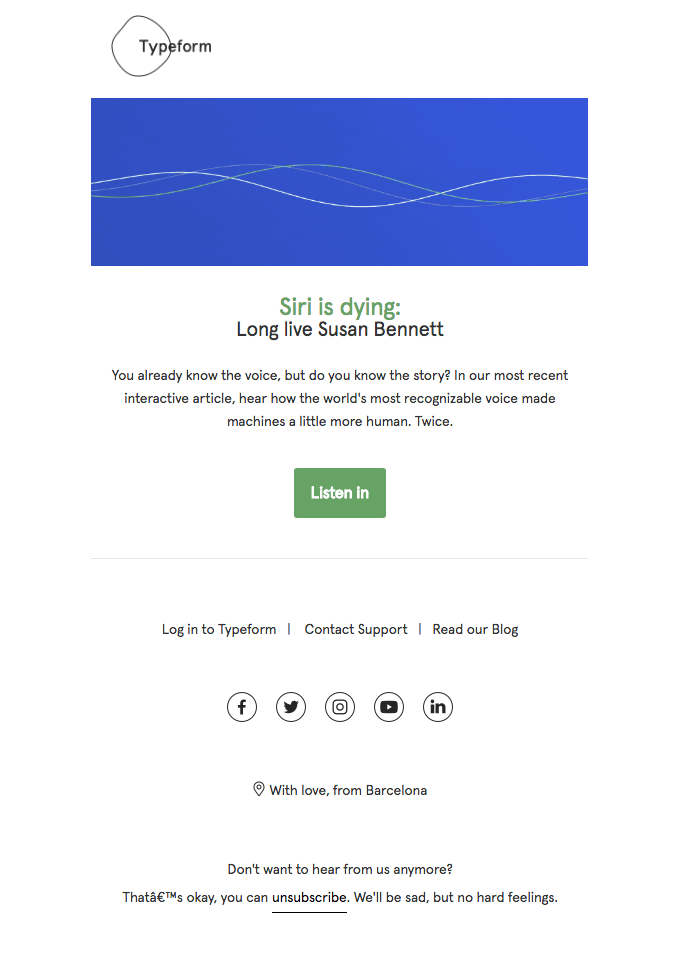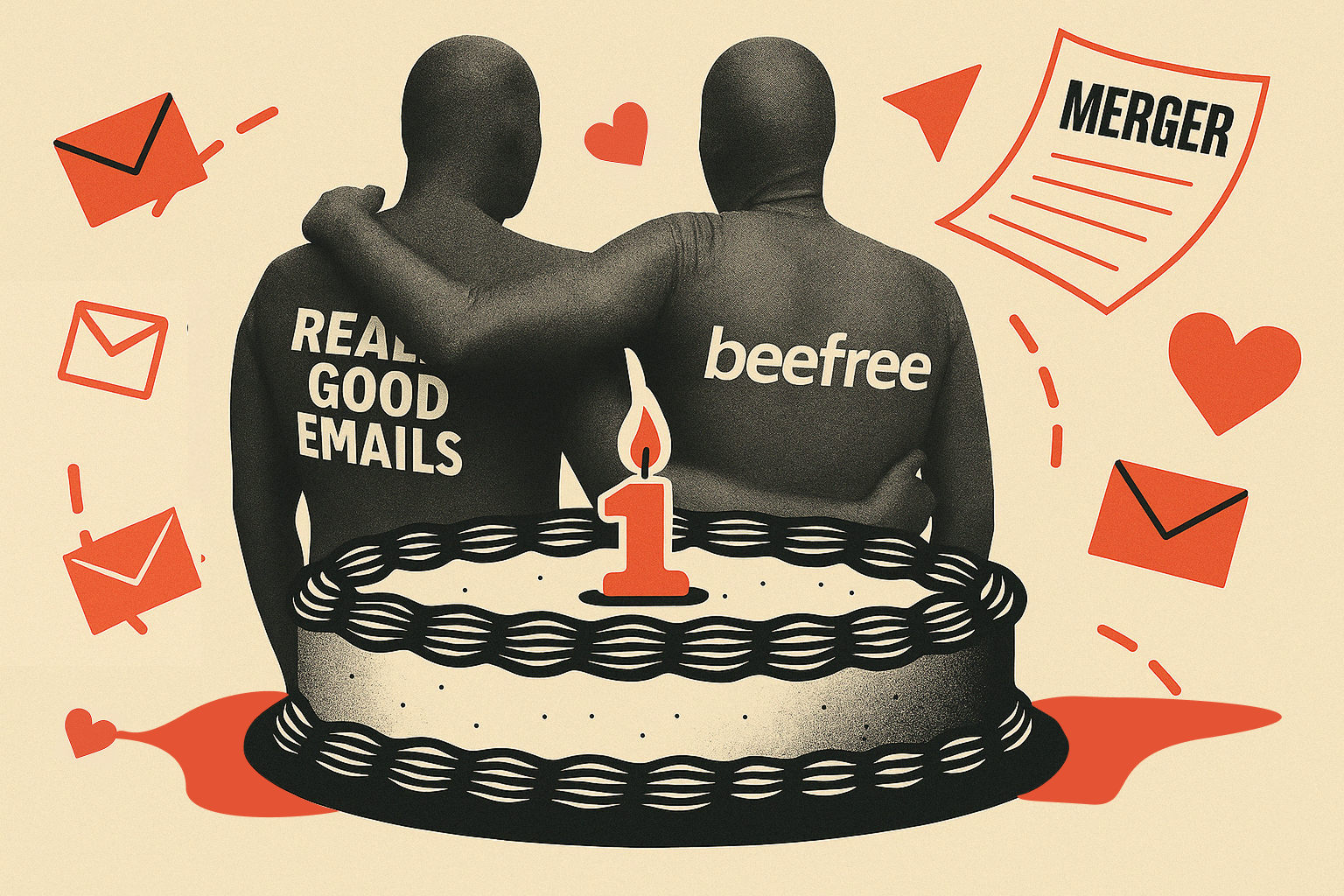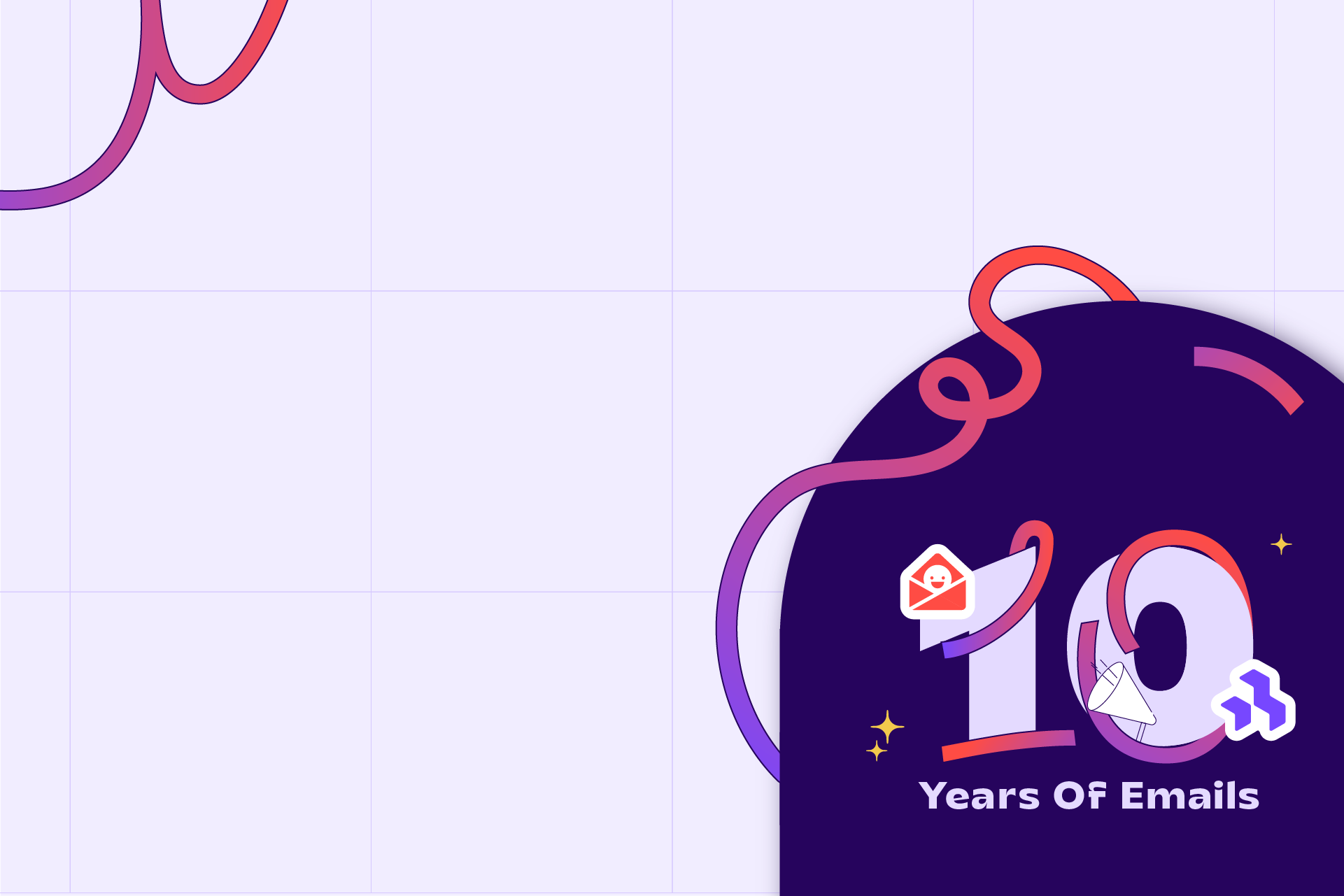We’re pretty used to talking to Siri or Alexa these days (robot overlords though they’ll probably turn out to be), but filling out online forms can be right up there with standing in line at the DMV to make us feel like a cog in the machine. Not so with Typeform.
Offering templates and tools to build everything from job applications to wedding invitations to trivia quizzes, Typeform strives to make data collection personal. Conversational. Fun, even! After going through a huge rebranding over the past year, Typeform has made it a point to really foreground the humanity behind online forms. And they’ve sent some pretty great emails about it.
So, we were excited to chat with Suzie Docherty (Typeform’s Email Marketing Manager) about the opportunities that emerged from the company’s rebranding, the importance of the human connection, and the challenges of engaging such a broad range of users.
Typeform just went through a huge rebranding process at the start of this year — what has that process looked like, and how has that affected email and your job?
During the rebrand, we actually took the opportunity to move ESP as well. So, we shifted from the old automation platform and also shifted to the new-look emails. I’d say that the new look is a work in progress. We’re constantly working on the actual email designs to bring them up to scratch because there were obviously quite a large number of them to change and improve. But one good thing about that, actually, is that it showed me the need for simplification of a lot of the stuff that we do.
So, what’s a specific place where you saw an opportunity for simplification?
One of the areas we’re currently experimenting with is our onboarding emails. Onboarding is one of those things that’s in a constant state of flux — you want to keep changing it, optimizing it, and hopefully not rely too much on email to get users to value to be honest. We have quite a complex journey at the moment, which is segmented by plan. So whenever you change your plan, you get a different set of emails. That’s quite hard to maintain and optimize. We’ve got some theories about things that might work, and we really want to streamline the design, so we’re testing a few things right now that should make them a lot cleaner and effective.

Typeform’s current onboarding email.
What kinds of emails have the best performance for Typeform, and what do you measure?
We measure all the standard things, you know, click through rate, open rate, all of that usual stuff. We also look at engagement with the platform after the fact, obviously, to see what direct impact X campaign had on a related event or a related feature, and the monetary impact where possible. Also we’ll look at things like social media to see the response, as interaction with our audience is really important to us.
For example, one of the recent ones, our GDPR email (a really unpopular subject that we were quite nervous about sending an email on anyway) got an amazing reaction on social, which is something we just never predicted.
We kind of went with something a little bit jokey when it came to the copy. It was the first time we’ve actually ever thought about holding back on an email. It’s a subject we took really seriously and we wanted to be sure we were striking the right chord given the subject. But, being Typeform, we couldn’t just go for the functional — we had to stay true to our voice and be playful with it. But people really responded to it because they loved the fact that it was just trying to — not make light — but make it more palatable and more approachable. Human, as we would put it.

Typeform’s GDPR email.
That’s a good example of how something that you have to do, something that is more functional, can turn into a boost for you and can really have a nice effect. The responses on social were great for that.
Similarly with our Black Friday campaign. We simply tested the subject line for that one, which, I admit, I don’t know if it worked every time, but the subject line was, “I bet this email is about Black Friday and this one, too” with emoji hands pointing up and down. And when it did land — which it landed quite a bit — the social response on that was fantastic as well.

Typeform’s well-played Black Friday subject line.
So, I think on these ones, you’re not always just looking for the open rates or platform engagement. It’s making people excited about receiving the email and understanding that there’s a human behind them.
What are you most excited about with your email program?
I think it’s quite a good time for us because we’ve just recently restructured. So we’re drawing on the knowledge of lots of different teams now (Growth, Customer Experience, Marketing) to really try and look into what we’re doing across the board, trying to optimize and experiment a lot more than we’ve been previously able to. It’s always the case, if you get more buy-in from lots of different people, you can make things happen a lot more.
In terms of a single feature I want to experiment with more — we actually have one where you can start filling out a typeform in an email (depending on what type of question it is). I’d love if we could start sending a full typeform that can be answered directly in an email, but this is a good start. I think it’s such a USP, being able to market a product through using it.
How does Typeform approach email and which projects to prioritize? How long does it usually take to get an email out the door?
We always try and be conversational and to relate to people. But even more so in email, we always want to ensure we’re providing value. When creating a campaign, I always try and think about how I would feel on the receiving end of it. I think that’s something that we all do here, no matter the discipline — we’re all quite good at considering the human aspect.
At the moment we’re trying to not just think about email, but all the other touch-points in a far more comprehensive way. We’re also trying to be far more collaborative. Basically, anyone can bring an idea for a project. If there’s a good one which could have a direct impact on the user experience or revenue , we’ll try and prioritize it. We’re trying to shift to a far more holistic cross-channel strategy, so that can impact the timescale. The volume of work, I would say, is quite large — particularly since until very recently, I was a team of one. I was doing the copy, strategy, testing, and everything for email, so that could sometimes prevent things moving as quickly as I would have liked. So, it kind of depends on where the initiative’s coming from. Sometimes it can be as quick as a day for a single email, or it can take a couple of weeks for a full campaign. It just depends on the scope.
What kinds of tests are you currently running? Are there any that you’ve run lately that have been interesting? Any results you can share?
We’re of course running simple ones constantly — standard copy, subject line type tests all the time. One thing we’re really trying to understand more is the impact of email as a channel, so that we can measure whether email is actually the best medium for any specific communications.
Not so much for A/B tests, but increased personalization is really important to us right now, so it’s something I really want to improve in our emails. No conclusive results yet, but we’re working on it! We’ve definitely noticed whenever we use the name of the person’s typeform [e.g. your “Game of Thrones Quiz”] in the email or in the subject line, that tends to get quite good engagement for us. We’re quite lucky with the tool that we use to automate our emails (which is Autopilot) as there’s actually a Typeform integration in it, so we can also trigger emails based on people’s activity on a specific typeform.
Because Typeform’s a fantastic product, it’s got loads of different uses, but we’re aware that people sometimes don’t know what to do with it after they’ve used it for their specific task. So that’s where we need to step in with relevant content. But we found that if we use the name of the last Typeform that they used (e.g. “Jenny’s Party Invitation”) in the email subject line, then we can send different use cases and different bits of inspiration based on what they last did. That’s something that tends to work quite well for us .
Do you have other re-engagement strategies or strategies for getting people to use Typeform more than once?
That’s an ongoing challenge, obviously, and something we’re testing a lot. I would say providing a combination of product tips, inspiration, and new feature releases are some of the key elements we employ just now via email. It’s definitely a work-in-progress, but giving inspirational cases and really showing other use cases has been the most successful thing for us.

What are the challenges in sending those re-engagement emails?
One of the big challenges is knowing what the next successful use case would be for that person. Essentially, people use Typeform to collect information from people that matter to them. So, this varies hugely between a business or a personal use. If someone’s using it for business for something like a job application or survey, those kind of things, you could potentially go on to do loads of different things with it. You can also use it for quizzes, for polls, contents, tests. Because it is such a useful world product, trying to pinpoint exactly what to engage people with, at the right time, is a bit of a challenge.
Earlier you said you segment by plan. Do you also segment by sort of business and personal? Do you have other segments, or is that the primary?
The plan segmentation is really just for the initial messages. We use a lot of actions in the platform to determine what we would send for behavioral things. So, if someone has been actively using a certain feature, has been doing this, that, and the other, we can segment by that. It’s really important to us that we look at the cues people are giving us through their actions and inactions, so that we can try and understand their needs and provide value at the right time. Also, we’re trying something pretty simple just now — asking people what they’re looking for directly. We’re a conversational platform, it’s important that we practice what we preach to get people to the right place.
What is your biggest headache/pain point in email?
One of the specific challenges is understanding the people that we have using our product. Because Typeform has so many potential use cases, really trying to understand where people want to go next can be a big challenge for everyone. So trying to ensure that we’re sending the right kind of content to people is vital. Keeping it relevant to the individual is a bit of an ongoing dilemma.

Are you ever afraid that you’re maybe over-communicating things? How do you manage that cadence?
I think it’s striking the right balance and owning the strategy by having data to back up our decisions. So, finding a balance between our business needs and what people will benefit from is the goal.
I always try to minimize where possible. You don’t want to be irrelevant to someone — that to me is the worst thing if you’re an email marketer. So, erring on the side of caution is important. But at the same time, one of the principles that we’ve written into the email team is just to be there at the right time. So, what that right time is, I think, depends on the content and the purpose of the email, and the user’s behavior. If that right time happens to be one day after you’ve received another email, I think that’s okay.
Do you like having control of the copy and subject lines and seeing what works? Do you like having access to the data and knowing if a certain word is performing really well, or is that overwhelming?
For me, there’s been a real satisfaction about working on the copy, but it’s something I’m less hands-on with now since we have some great copywriters here. It’s full of surprises. It’s often things that you don’t necessarily think are going to work that have surprising results. But it is nice when things are justified in your head about ideas that you thought might work. Especially when you get a follow up on social and it works in that way as well. It’s nice when an email makes it out of the inbox and onto another channel.
Especially after this rebrand, Typeform seems very culture-focused, especially on social. Is there a model you guys are pushing forward as a company, or is there something you try to think about every time you send an email?
Yeah, definitely. Thinking about the people behind anything is something that comes from from the core of Typeform. It’s the people in the company that really make it an interesting and special place to work, but that same feeling goes through to everything that everyone does, and probably more so in email and social than anywhere else because it’s that direct connection with our audience. So, that’s why I said for me it’s always so important to really think about who you’re talking to and not to patronize and always to just write it like you would talk to someone. If you wouldn’t say it in a conversation, don’t write it because that’s how it should always sound to us. That’s really important.

What’s something you look forward to seeing in your email inbox?
Something surprising, no matter what it is. So, if it’s just not what you’re used to seeing from every other email, then that’s good for me, and I will probably bookmark it. One of the recent ones that comes to mind — there’s a really good newsletter that a lot of us have signed up to called The Hustle. It’s kind of a marketing newsletter, but they basically spice up what other people might deem boring information. And they do nice work with their subject lines!
Lesson Learned: It’s a fact — we gravitate toward brands that don’t take themselves too seriously. So, be playful. Be helpful. Give your users new ideas, keep things simple, and always be human. Unless you’re a robot. Then be a robot.








